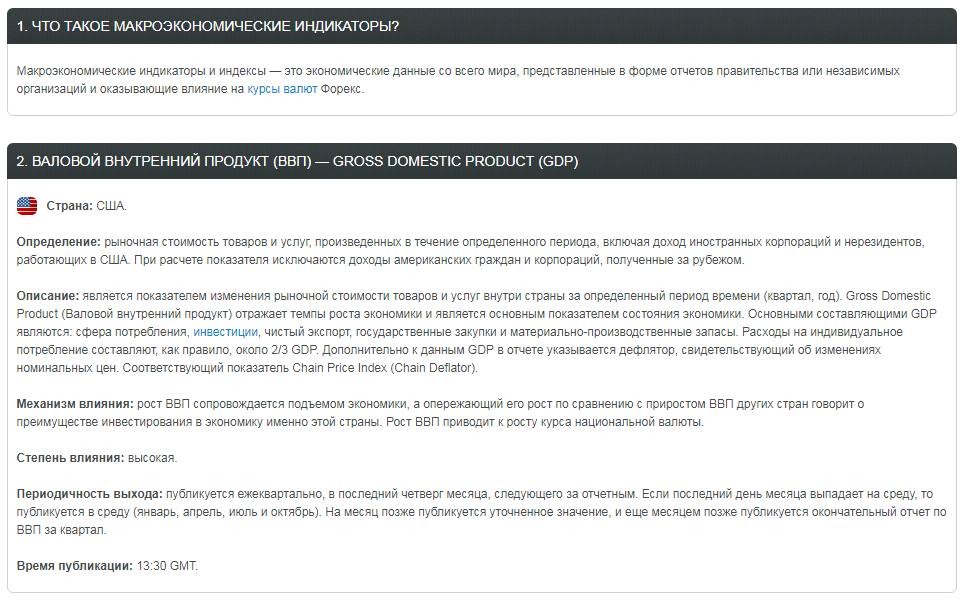Макроэкономические индикаторы форекс
Не секрет что существует два основных метода исследование рынка - технический и фундаментальный анализ.

Первый тип анализа, а именно технический, рассчитан на анализ инерции движения рынка, поведения толпы и психологический анализ той или иной категории трейдеров.
Второй вид исследования основывается на изучении экономики страны, ее потенциала, а также факторов, которые могут влиять на изменение курса национальной валюты.
Стоит заметить, что оба эти вида анализа, так или иначе, взаимосвязаны и эффективны.
Однако стоит четко понимать, что любые сильные изменения котировок выбранного актива всегда происходят на экономической почве.
Фундаментальный анализ не возможно производить без исходных данных об экономике страны, поэтому для информирования инвесторов, трейдеров, а также сознательных граждан правительство и крупнейшие рейтинговые агентства на постоянной основе публикуют макроэкономическую статистику.
Макроэкономические индикаторы форекс – это статистика, которая специально публикуется правительством стран, а также крупными рейтинговыми агентствами (институтами) для мониторинга экономики и хода ее развития для потенциальных инвесторов.
Макроэкономические индикаторы форекс являются сырьем для принятия решения трейдерами и инвесторами проводящие фундаментальный анализ, что оказывает огромное влияние на курс валют. Публикация статистики происходит на регулярной и постоянной основе.
Степень влияния макроэкономических индикаторов
По степени влияния на рынок и курс валют все макроэкономические индикаторы можно разбить условно на три группы, а именно на высокое, среднее и низкое.
Для того чтобы вы могли отличать макроэкономические индикаторы по степени влияния на рынок мы решили разбить их на группы и сделать краткий перечень каждой из них.
Высокая степень влияния на рынок
К высоким по степени влияния на рынок макроэкономическим индикаторам относится следующая статистика: валовый внутренний продукт (ВВП), процентная ставка, индекс потребительских цен, отчет главы Центробанка (в независимости какой страны), пособия по безработице, платежный баланс, количество новых рабочих мест, ставка рефинансирования, торговый баланс.
Публикация статистики вопреки с ожиданиями инвесторов приводит к сильным курсовым изменениям, вплоть до окончания и формирования нового тренда.
Средняя степень влияния на рынок
К средней по степени влияния на рынок относится следующая макроэкономическая статистика: объем заказов на товары длительного использования, индекс деловой активности, индекс доверия потребителей, индекс промышленного производства, производительность труда, изменение продаж в розничной сфере, уровень безработицы. Публикация статистики средней по степени влияния приводит активность рынка в пределах от 20 до 100 пунктов.
Низкая степень влияния на рынок
К низким по степени влияния макроэкономическим индикаторам относятся: использование производственных мощностей, личные доходы, первичное обращение безработных, производственные заказы, бежевая книга, а также ряд других второстепенных еженедельных ежемесячных макроэкономических индикаторов.
Стоит заметить, что публикация статистики с низкой степенью влияния на рынок может вовсе не отобразится на котировках валют, либо движение цены будет находиться в пределах 20 пунктов.
Для того чтобы познакомится с каждым макроэкономическим индикаторам и узнать принцип его подсчета и степень влияния на рынок перейдите в раздел Аналитика – Фундаментальный анализ - Макроэкономические индикаторы и индексы у брокера Альпари - https://alpari.com/ru/.

Принцип применения макроэкономических индикаторов на форекс
Если рассматривать принципы применения макроэкономических индикаторов на форекс то их можно разбить на две группы, а именно торговля на ожиданиях и торговля после публикации.
Торговля на ожиданиях происходит за счет сравнения ожидаемых данных по статистике со стороны инвесторов и прошлой публикации данных.
Стоит заметить, что данный подход обеспечивает самую выгодную точку входа в рынок, но в тоже время делает уязвимым трейдера в момент самой публикации в случае, если статистика расходится с ожиданиями.
Торговля после публикации новости статистики более популярный вариант, однако, для его реализации вам потребуется наличие моментального рыночного исполнения ордеров у брокера и отсутствие проскальзывания.
Данные по публикации макроэкономическим индикаторам форекс, а именно четкое время, значение текущее, предыдущее и ожидаемое вы можете найти в специальном экономическом календаре.
В заключение стоит отметить, что макроэкономические индикаторы являются тем самым фактором, которое заставляет двигаться рынок, а понимание и владение статистикой делает эти движения рынка для трейдера более предсказуемыми.

